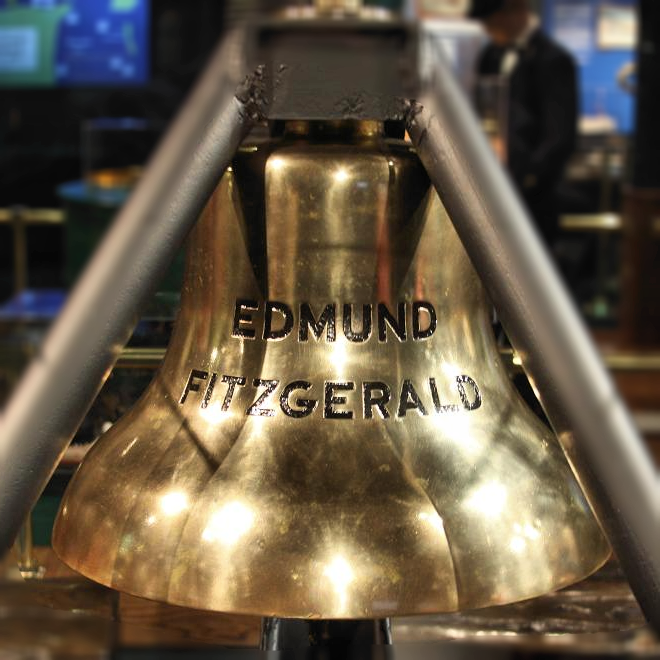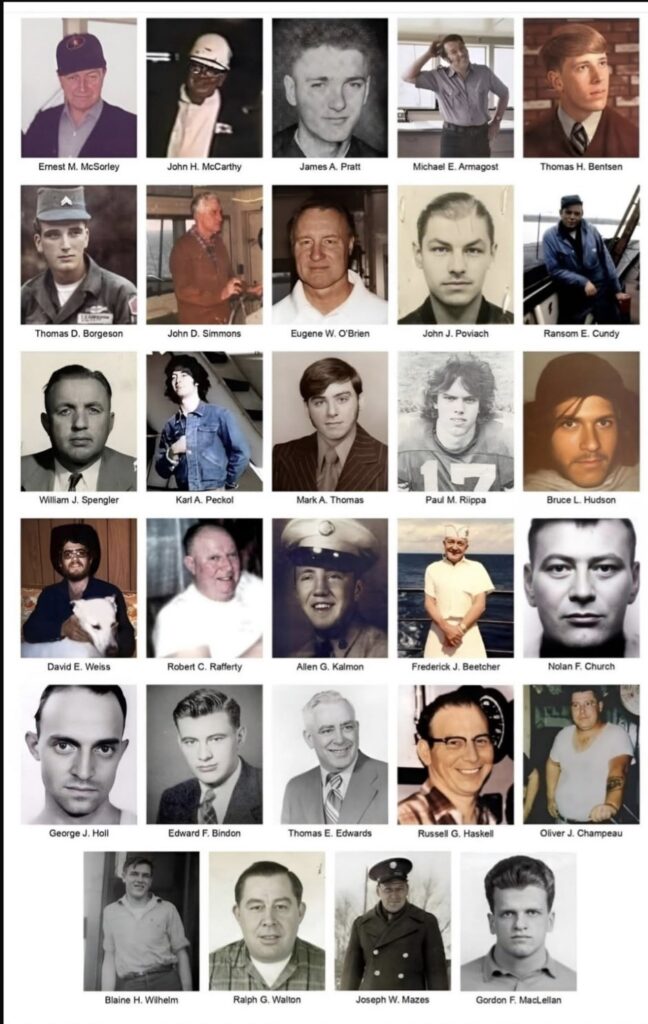In a musty old hall in Detroit they prayed
In the Maritime Sailors’ Cathedral
The church bell chimed, ’til it rang 29 times
For each man on the Edmund Fitzgerald.
The legend lives on from the Chippewa on down
Of the big lake they call Gitche Gumee
Superior, they say, never gives up her dead
When the gales of November come early.
Gordon Lightfoot, The Wreck of the Edmund Fitzgerald
Today is the 50th anniversary of the sinking of the Edmund Fitzgerald, the 729-foot-long freighter that disappeared below Lake Superior in 1975, taking its 29-member crew with it. Launched in 1958, the Edmund Fitzgerald was the largest ship on the Great Lakes. It remains the largest of the estimated 6,500 ships that have gone down in the Great Lakes. Made famous by Gordon Lightfoot song, the ship was carrying 26,000 tons of iron ore pellets when it sank, caught in storm carrying hurricane-strength winds.
The Edmund Fitzgerald and its 29 crew members now rest 530 below the surface of Lake Superior. Its 200-pound bronze bell was retrieved on July 4, 1995, and is displayed at the Great Lakes Shipwreck Museum at Whitefish Point as a memorial to the crew.
It’s never been definitively determined why the Edmund Fitzgerald sank. The Coast Guard Marine Board of Investigation and the National Transportation Safety Board suspected flooding through the ship’s topside hatches, flooding the cargo hold.
The Coast Guard report noted that the sinking of the Edmund Fitzgerald happened so quickly, no deployment of lifeboats occurred, nor a mayday distress call sent over the ship’s radio — despite the ship’s crew having been on the radio with the nearby freighter Arthur M. Anderson just minutes before on the evening of Nov. 10.
The report further noted that the Fitzgerald’s positioning on the Lake Superior bottom — its front section upright and looking as if it collided with the muddy bottom at speed; the middle section of the ship disintegrated and the rear section capsized and nearly perpendicular but less than 200 feet from the front section on the lake bottom — tend to indicate the ship didn’t suffer a structural breaking apart on the lake surface, as the ship halves would have likely remained buoyant for at least a brief time and the raging, 50-knot winds would have taken the two ship halves farther from one another.
The damaged sign of the SS Edmund Fitzgerald shipwreck as seen from a diving submarine.
The marine board walked through how a loss of buoyancy due to severe topside flooding through the ship’s faulty or failing hatches potentially unfolded on the fateful night of Nov. 10, 1975.
“Finally, as the storm reached its peak intensity, so much freeboard was lost that the bow pitched down and dove into a wall of water, and the vessel was unable to recover,” the report states. “Within a matter of seconds, the cargo (26,000 tons of iron ore taconite pellets) rushed forward, the bow plowed into the bottom of the lake, and the midships structure disintegrated, allowing the submerged stern section, now emptied of cargo, to roll over and override the other structure, finally coming to rest upside-down atop the disintegrated middle portion of the ship.”
Others think the ship may have sunk from damage to its hull from bottoming out on a shoal, a shallower area in the lake due to rocks and sandbars. Still others believe the ships structural problems doomed it.
After the death of singer Gordon Lightfoot on May 1, 2023, the church bell was ceremonially rung 29 times in memory of the crew, plus an additional ring in memory of Lightfoot who committed their deaths to posterity.
Postscript: An observant commenter below notes that an NPR story this morning observed that “the wreck of the Edmund Fitzgerald helped change safety standards. There has not been a single major commercial shipwreck on the Great Lakes, he says, for the past 50 years.”
Also, if you’re interested in more about the Edmund Fitzgerald, numerous long articles were published today and in the preceding weeks, including a New York Times podcast with John U. Bacon has written a new account of the disaster, “The Gales of November: The Untold Story of the Edmund Fitzgerald.”
All That Remains Is The Faces And The Names
The faces and the names of the 29 crew members of the Edmund Fitzgerald are listed below.

Michael E. Armagost, 37
Fred J. Beetcher, 56
Thomas D. Bentsen, 23
Edward F. Bindon, 47
Thomas D. Borgeson, 41,
Oliver J. Champeau, 41,
Nolan S. Church, 55,
Ransom E. Cundy, 53,
Thomas E. Edwards, 50
Russell G. Haskell, 40
George J. Holl,60
Bruce L. Hudson, 22
Allen G. Kalmon, 43
Gordon F. MacLellan, 30
Joseph W. Mazes, 57
John H. McCarthy, 62
Ernest M. McSorley
Eugene W. O’Brien, 50
John J. Poviach, 59
James A. Pratt, 44
Robert C. Rafferty, 62
Paul M. Riippa, 22
John D. Simmons, 62
William J. Spengler, 59
Mark A. Thomas, 21
Ralph G. Walton, 58
David E. Weiss, 22
Blaine H. Wilhelm, 52

There’s a new book about this called The Gales of November, by John Bacon. Haven’t read it yet, but I plan to.
You may appreciate this story from the Cleveland Plain Dealer:
www.cleveland.com/news/2025/11/fifty-years-later-the-legend-of-the-edmund-fitzgerald-lives-on.html
Were the crew members represented by a union, and if so, which one? And also, if so, was the union a participant in the investigation? Did the union have any comment on the investigation’s conclusion?
20 of the 29 crew members were represented by United Steel Workers Local 5000. I’m not aware of how involved they were in the investigation.
Thanks for sharing. So many shipwrecks. Didn’t realize this was the largest ship to sink.
The story of the Edmund Fitzgerald memorialized by Gordon Lightfoot deeply affected me when the song was released almost 50 years ago, and revisiting that disaster today has revived all of those old feelings of grief for those who perished. However, I heard on NPR this morning that the aftermath of that wreck was a serious overhaul of ship safety regulations, and since 1975, no major commercial vessels have sunk in the Great Lakes. Workplace safety regulations and their enforcement make an enormous difference!
The story of the Edmund Fitzgerald memorialized by Gordon Lightfoot deeply affected me when the song was released almost 50 years ago, and revisiting that disaster today has revived all of those old feelings of grief for those who perished. However, I heard on NPR this morning that the aftermath of that wreck was a serious overhaul of ship safety regulations, and since 1975, no major commercial vessels have sunk in the Great Lakes. Workplace safety regulations and their enforcement make an enormous difference!
Earlier this year, the Mariners’ Church of Detroit (established in 1942) began its commemoration of the 50th anniversary. As it has done every year since 1975 the church bell will toll 29 times today, beginning at 12:10 pm (ET), to remember the “souls lost on the Edmund Fitzgerald.” The final event will be a luncheon symposium hosted by Detroit Mercy Law School entitled, “Sinking of the Edmund Fitzgerald: Exploring the Legal Issues Surrounding Deadly Shipwrecks and Honoring the 50th Anniversary of a Great Lakes Tragedy.”